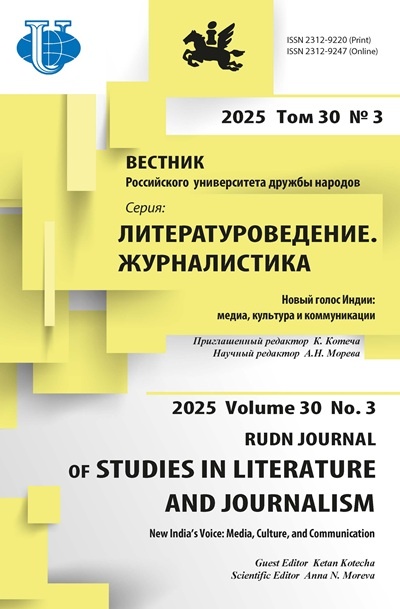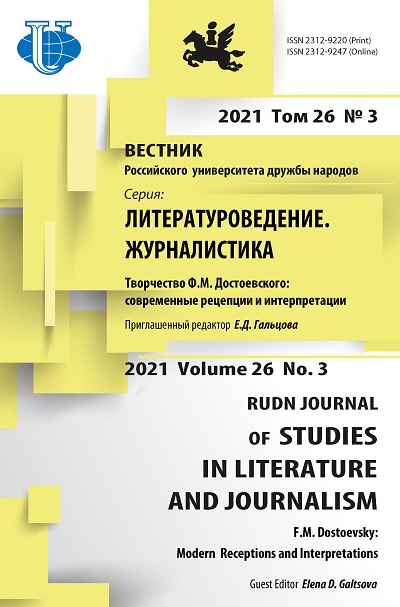Позитивизм в зеркале карнавала: раблезианский хронотоп в творчестве Э. Золя
- Авторы: Альбрехт О.В.1
-
Учреждения:
- Литературный институт им. А.М. Горького
- Выпуск: Том 26, № 3 (2021): ТВОРЧЕСТВО Ф.М. ДОСТОЕВСКОГО: СОВРЕМЕННЫЕ РЕЦЕПЦИИ И ИНТЕРПРЕТАЦИИ
- Страницы: 519-528
- Раздел: Литературоведение
- URL: https://journals.rudn.ru/literary-criticism/article/view/27653
- DOI: https://doi.org/10.22363/2312-9220-2021-26-3-519-528
- ID: 27653
Цитировать
Полный текст
Аннотация
В статье предлагается применить раблезианский «культурный код» к прочтению некоторых романов Э. Золя. С точки зрения автора, подобный эксперимент позволяет взглянуть на французский натурализм с новой точки зрения как на вариант типологически повторяющегося в истории литературы явления. Раблезианство рассматривается в статье как своеобразная смыслопорождающая модель для французского натуралистического романа, «присвоенная коммуникация» или элемент традиционного литературного дискурса, который актуализирован в эпоху, когда культурные условия и характер основных идеологических и эстетических конфликтов стали аналогичными эпохе французского Ренессанса. В статье осуществляется попытка применить к интерпретации некоторых текстов Э. Золя теорию «карнавального хронотопа» М.М. Бахтина, при этом понятие хронотопа рассматривается широко: предлагается понимать хронотоп как универсальную модель пространственно-временных отношений в романе. Также в статье выражены идеи относительно рассмотрения поэтики «реального» в натуралистическом романе через призму карнавального (предельно детализированного вещного мира); в качестве примеров проанализированы мотивы еды и вина, а также мотив бунта/войны как варианта «войны за еду» и карнавальной битвы Масленицы и Поста. Основной привлеченный для анализа материал взят из романов Э. Золя «Чрево Парижа» («Le Ventre de Paris», 1873), «Западня» («L’Assommoir», 1877), «Жерминаль» («Germinal», 1885).
Ключевые слова
Об авторах
Ольга Викторовна Альбрехт
Литературный институт им. А.М. Горького
Автор, ответственный за переписку.
Email: ars-kos@yandex.ru
ORCID iD: 0000-0002-9359-8237
аспирант каф. зарубежной литературы Литературного института им. А.М. Горького; старший преподаватель каф. славянской филологии ПСТГУ
Российская Федерация, 123104, Москва, Тверской б-р, д. 25Список литературы
- Смирнов И.П. Порождение интертекста. Элементы интертекстуального анализа с примерами из творчества Б.Л. Пастернака. СПб.: Языковой центр филологического факультета СПбГУ, 1995. 190 с.
- Barthes R. Le mythe, aujourd’hui // R. Barthes. Mythologies. Ed. du Seuil, 1970. Р. 191-247.
- Бахтин М.М. Формы времени и хронотопа в романе // М.М. Бахтин. Собрание сочинений. Т. 3. Теория романа. М.: Языки славянских культур, 2012. С. 340-511
- Золя Э. Из сборника «Экспериментальный роман» // Э. Золя. Собр. соч.: в 26 т. Т. 24. М.: Художественная литература, 1966. С. 321-410
- Барт Р. Эффект реальности // Р. Барт. Избранные работы. Семиотика. Поэтика. М.: Прогресс, 1994. С. 392-400.
- Зенкин С. Теория литературы. Проблемы и результаты. М.: Новое литературное обозрение, 2018. 368 с.
- Бахтин М.М. Творчество Франсуа Рабле и народная культура средневековья и Ренессанса. М.: Эксмо, 2015. 640 с.
- Barthes R. Semioligie et urbanisme // R. Barthes. L’aventure sémiologique / ed. du Seuil, 1985. P. 261-271.
- Силантьева О.Ю. Страна Кокань и Шлараффия во французской и немецкой литературе XVIII-XIX веков: дис.. канд. филол. наук. М.: РГГУ, 2006. 380 с.
- Scarpa M. Le Carnrval des Halles : Une ethnocritique du « Ventre du Paris » de Zola. P., 2000. 304 p.
- Zola E. Le ventre de Paris (комментарии) // E. Zola. Oeuvres complètes en 15 T. T. 2. P., Cercle du livre précieux, 1967. P. 561-821.
- Larousse, petit dictionnaire de Français. Рaris, 2006. Р. 54
Дополнительные файлы















